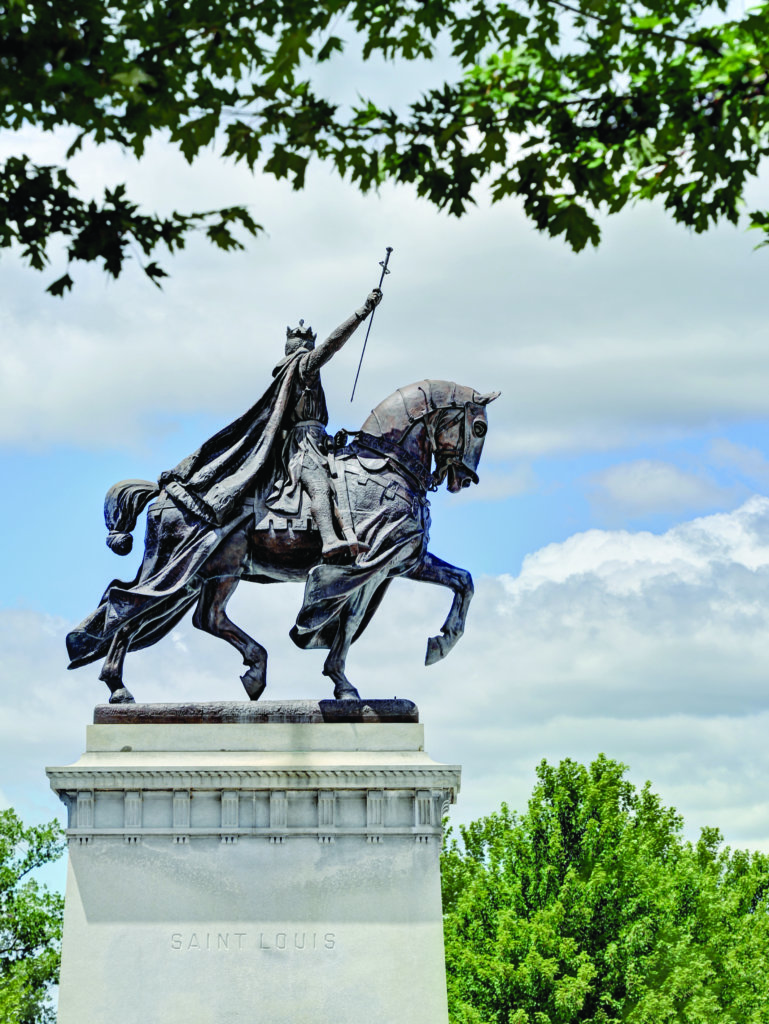
 The Apotheosis of St. Louis sits atop what St. Louisans know as Art Hill, a high point in the city in front of the Saint Louis Art Museum. From there, the bronze-cast statue of our city’s namesake, King Louis IX, overlooks the city from one of its most popular cultural stations. Originally unveiled during the 1904 World’s Fair, the plaster cast by Charles Henry Niehaus was so well received that a bronze replica was made and donated to Forest Park, where it has lived for over a century.
The Apotheosis of St. Louis sits atop what St. Louisans know as Art Hill, a high point in the city in front of the Saint Louis Art Museum. From there, the bronze-cast statue of our city’s namesake, King Louis IX, overlooks the city from one of its most popular cultural stations. Originally unveiled during the 1904 World’s Fair, the plaster cast by Charles Henry Niehaus was so well received that a bronze replica was made and donated to Forest Park, where it has lived for over a century.
The statue features the French king (a.k.a. Saint Louis) gallantly perched on his majestic steed in a position of leadership. He holds a sword, but not for battle. With the blade in hand and the hilt to the sky, the statue seems to indicate that Saint Louis is handing over responsibility to care for the city—and he’s doing so in peace.

A hop, a skip, and a jump away, at the intersection of Wydown and Hanley, sits another noteworthy equestrian statue: Fernando Botero’s “Man on a Horse”. This bronze statue was cast in 1999 and went on display in Venice, Italy and in New York City before being acquired by the Gateway Foundation, who placed it in Clayton in 2005.
Graceful as he appears, this figure is less… regal. Both the man and his horse could be described as cartoonishly rotund, infantile, and even distorted. These outsized figures are Botero’s signature, and while he neutrally insists that the tubby subjects represent a mere exploration in aesthetics, many critics agree that they make a satirical impression.
The biographies of both Fernando Botero and Saint Louis make this what might be an incidental satire and a fascinating crossroads of culture.
The connection between Fernando Botero and the literary genre of Magical Realism is worth noting in this context, as both came about in Colombia in the 1930s. Magical Realism is a movement and style that blurred the line between the natural and the supernatural. This Latin American tradition presents magical events as ordinary occurrences so that outsized people and events fit seamlessly into the expectations of reality. This heightened reality becomes a language unto itself, able to communicate truth in ways that more grounded forms cannot.
Across the ocean in Europe, Surrealism, the cultural movement known for the juxtaposition of realities to challenge the mind, a concept not too dissimilar from Magical Realism, had emerged only a decade earlier. Later, in France, where the term “Bouffon” was re-coined, comedic theatre saw a boom through the work of Jacques Leqoc. The French term “Bouffon” originated from the English word “buffoon” and is derived from the Latin word “buffare,” meaning “to puff,” which inevitably makes us think of Botero’s puffy figures. A bouffon is a sort of anti-clown: while a clown is the subject of laughter for the audience, the Bouffon is a distorted and grotesque figure that flips the script. The style’s founder puts it best:
“While we make fun of the clown, the bouffon makes fun of us. At the heart of the bouffon is mockery pushed to the point of parody. Bouffons amuse themselves by reproducing the life of man in their own way, through games and pranks. The parody isn’t directly offensive with regard to the public; there is no deliberate intention to mock—the relation is of a different order. Bouffons come from elsewhere.” – Jacques Lecoq
Like a Bouffon, Botero’s sculptures might prod at humanity’s shortcomings with a sense of play. “Man on a Horse” communicates undeniable humor; it is not uncommon for it to draw a chuckle or a smirk from onlookers. Whether the presence of “Man on a Horse” is an intentional parody of the “Apotheosis of St. Louis” or not, it can certainly serve as an invitation to see ourselves and those around us from a fresh perspective. Art supplies us the ability to stretch the confines of reality in such a way that can reveal truth and perspective about our history and humanity.
As our city’s past crystalizes into legend, the contrast and connection between our two horsemen can inspire us to advance our legacy with a sense of self-awareness. The key to our growth as individuals and as a community is in recognizing our strengths, successes, weaknesses, and biases in order to take accountability for them. Doing so may lead us to a more complete, honest, and humble understanding of who we are and even more importantly, who we could be.